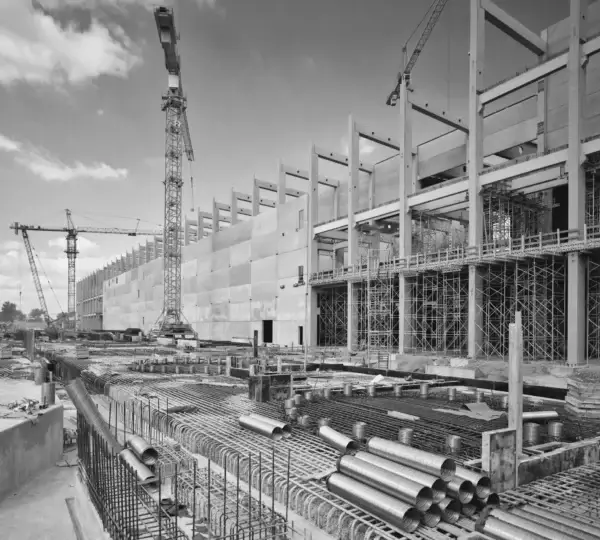In the fast-paced world of construction, temporary construction lighting plays a critical role in ensuring safety, productivity, and regulatory compliance. Proper lighting doesn’t just improve visibility—it protects workers, reduces risks, and boosts efficiency. At Worksite Lighting, we specialize in effective and durable lighting solutions tailored to temporary construction needs. Let’s explore how to select the right lights for your worksite and how to meet safety standards efficiently.
The Importance of Temporary Construction Lighting
Effective temporary lighting is essential for several reasons:
- Visibility: Proper illumination ensures workers can see potential hazards, reducing the risk of accidents.
- Safety Compliance: Lighting must meet OSHA regulations to avoid fines and ensure worker protection.
- Productivity: Adequate lighting allows work to continue efficiently, even during nighttime or low-light conditions.
Different tasks and environments require specific lighting setups. Here are key factors to consider:
- Work Area Size: Use high-output lights for large spaces and portable solutions for smaller, enclosed areas.
- Task Type: Detailed tasks may require focused or hands-free lighting.
- Safety Standards: Always ensure your lighting choices comply with OSHA regulations.
Check out our wide range of lighting options tailored for different worksite needs:
Explore Temporary Construction Lighting Solutions
Types of Temporary Construction Lights
Different types of temporary construction lights cater to various needs. Here’s a breakdown of the most commonly used solutions:
1. LED Tower Lights
- Best For: Large, open construction sites.
- Benefits:
- Energy-efficient with high lumens output.
- Illuminates wide areas with fewer units.
- Long-lasting and durable.
2. String Lights
- Best For: Pathways, corridors, and confined spaces.
- Benefits:
- Provides consistent, linear illumination.
- Flexible installation for varied layouts.
- Easy to set up and move.
Browse String Lights for Your Worksite
3. Portable Floodlights
- Best For: Focused lighting in specific work zones.
- Benefits:
- Highly portable and easy to reposition.
- Adjustable angles for targeted illumination.
- Delivers intense brightness where needed.
Check Out Portable Floodlights
4. Headlamps
- Best For: Workers needing hands-free illumination.
- Benefits:
- Portable, personal lighting.
- Ideal for confined or detailed work.
- Increases worker mobility and safety.
Choosing a combination of these lights ensures optimal visibility across your entire site.
Meeting OSHA Requirements for Construction Lighting
Ensuring compliance with OSHA lighting standards is crucial for safety and avoiding penalties. Here are key guidelines:
1. Minimum Illumination Levels
Different construction zones require specific foot-candle levels:
- General Construction Areas: Minimum of 5 foot-candles.
- Workshops and Assembly Areas: 10 foot-candles.
- Stairs and Exit Routes: 5 foot-candles.
2. Emergency Lighting
Always have backup lighting systems in place to maintain safety during power outages.
3. Electrical Safety Standards
Ensure all lighting equipment follows OSHA’s electrical safety standards:
- Proper grounding and insulation.
- Protection from electrical hazards.
- Routine inspections for damage or wear.
For OSHA-compliant lighting, explore our solutions here:
OSHA-Compliant Worksite Lights
Optimal Placement of Construction Site Lights
Strategic light placement improves safety and productivity. Consider these tips:
1. Focus on High-Risk Areas
- Key Zones: Stairs, ledges, machinery, and entry/exit points.
- Ensure these areas are consistently well-lit.
2. Minimize Shadows
- Use overlapping light sources to eliminate shadowy spots where hazards may hide.
3. Control Glare
- Direct lights downward and use diffusers to reduce glare that can impair vision.
Proper placement ensures not only brightness but also a safe and comfortable work environment.
Powering Your Temporary Construction Lights
Selecting the right power source is vital for effective lighting. Here are the main options:
1. Generator-Powered Lights
- Best For: Remote, off-grid sites.
- Benefits:
- Provides reliable, continuous power.
- Suitable for high-output lighting systems.
2. Battery-Operated Lights
- Best For: Portable needs where cables are impractical.
- Benefits:
- No need for external power sources.
- Easy to move and set up.
3. Solar-Powered Lights
- Best For: Environmentally friendly and cost-effective lighting.
- Benefits:
- Charges during the day for nighttime use.
- Reduces fuel and electricity costs.
Power Distribution Solutions
Efficient power distribution keeps your lighting systems running smoothly. Avoid downtime with reliable distribution units:
Explore Portable Power Distribution
Cost-Effective Lighting Solutions for Construction Sites
Balancing quality and budget is key when choosing temporary construction lights. Here’s how to maximize your investment:
1. Use LED Technology
- Benefits: Energy-efficient, durable, and low maintenance.
2. Rent Lighting Equipment
- Best For: Short-term projects.
- Reduces upfront costs and gives access to the latest technology.
3. Opt for Versatile Lights
- Choose lights that serve multiple purposes to minimize equipment needs.
Find cost-effective lighting options here:
Explore our Rental Lights
Conclusion
Selecting the right temporary construction lighting is essential for safety, compliance, and productivity. By understanding different lighting types, adhering to OSHA standards, and planning strategic placement, you can create a safer, more efficient construction site. Invest in reliable, compliant lighting solutions and power options to keep your project running smoothly and your workers protected.
Explore our complete range of worksite lighting solutions:
Explore more Lighting Options


